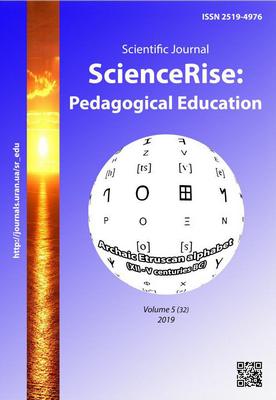Variable correctional component in physical rehabilitation of early age children with a spastic type of motor disorders
DOI:
https://doi.org/10.15587/2519-4984.2019.179465Keywords:
variability, correction, spastic syndrome, motor impairment, young children, hemiparesisAbstract
The article examines aspects of the relationship of the component constant of the strategy of correction and the variable component of the correction process. The possibilities of tactical variation of corrective measures are shown depending on the level of localization of the depression center of the central nervous system in young children with spastic syndrome of movement disorders. First of all, this refers to the mental development of children with cerebral level of oppression, since such children may have problems with speech development and behavior. This may complicate the process of remedial physical education of this contingent of children. The mental development of children with cervical oppression is less vulnerable, but with this option, the relevance of contraindications in physical rehabilitation is enhanced. The features of topography of spastic paresis in cerebral and cervical variants (monoparesis, paraparesis, triparesis, tetraparesis), as well as their greater manifestation in certain limbs (hemiparetic variant), are considered. The necessity of a more systematic approach to the correction of motor disorders with a greater topographic extent of spastic paresis is shown.
The question of the specificity of cerebral and cervical spasticity due to the inhibition of various levels of localization is studied separately. Depending on the location of the center of CNS depression, the tactics of correcting movement disorders in children of this cohort should be modified, which should affect the means and methods of correction, the methodical techniques used and the subject-spatial component.
The author proposes variants of the variable approach algorithms for overcoming spastic-type motor disorders in young children, depending on initial inputs in the form of localization of CNS depression, paresis topography, as well as the specifics of the existing spasticity and degree of its manifestation.
The perspectives of research in this area should include the practical saturation of the developed algorithms with the methodological content in order to increase the degree of differentiation and individualization of correction by means of physical education
References
- Msall, M. E., Limperopoulos, C., Park, J. J. (2009). Neuroimaging and cerebral palsy in children. Minerva Pediatrica, 61 (4), 415–424.
- Sussman, M. D., Aiona, M. D. (2004). Treatment of spastic diplegia in patients with cerebral palsy. Journal of Pediatric Orthopaedics, Part B, 13 (2), S1–S12. doi: http://doi.org/10.1097/00009957-200403000-00016
- Yefymenko, M. M. (2014). Basics correction directed physical education of children with disorders of the musculoskeletal system. Kyiv, 441.
- Yefymenko, M. M. (2013). Suchasni pidkhody do korektsiino spriamovanoho fizychnoho vykhovannia doshkilnykiv z porushenniamy oporno-rukhovoho aparatu. Vinnytsia: Nilan – LTD, 356.
- Kozhevnikova, V. T. (2013). Sovremennye tekhnologii fizicheskoi reabilitacii bolnykh s posledstviiami perinatalnogo porazheniia nervnoi sistemy i detskim cerebralnym paralichom. Moscow: Madzhenta, 568.
- Uestraikh, N. G. (1997). Osnovnye metody fizicheskoi reabilitacii bolnykh s dvigatelnymi narusheniiami. Minsk, 194.
- Palchik, A. B., Shabalov, N. P. (2013). Gipoksicheski-ishemicheskaia encefalopatiia novorozhdennykh. Moscow: MED-press-inform, 288.
- Moga, N. D. (2018). Differencialnye podkhody k klassificirovaniiu spasticheskikh dvigatelnykh narushenii u detei. Naukovii chasopis, 35, 50‒61.
- Shevtsov, A. H. (2009). Osvitni osnovy reabilitolohii. Kyiv: Lesia, 483.
- Moga, M. D. (2012). Korektsiina stratehiia v fizychnomu vykhovanni ditei rannoho viku zi spastychnym typom rukhovykh porushen. Aktualni pytannia korektsiinoi osvity (pedahohichni nauky), 14, 228–238.
Downloads
Published
How to Cite
Issue
Section
License
Copyright (c) 2019 Moga Nikolay

This work is licensed under a Creative Commons Attribution 4.0 International License.
Our journal abides by the Creative Commons CC BY copyright rights and permissions for open access journals.
Authors, who are published in this journal, agree to the following conditions:
1. The authors reserve the right to authorship of the work and pass the first publication right of this work to the journal under the terms of a Creative Commons CC BY, which allows others to freely distribute the published research with the obligatory reference to the authors of the original work and the first publication of the work in this journal.
2. The authors have the right to conclude separate supplement agreements that relate to non-exclusive work distribution in the form in which it has been published by the journal (for example, to upload the work to the online storage of the journal or publish it as part of a monograph), provided that the reference to the first publication of the work in this journal is included.








